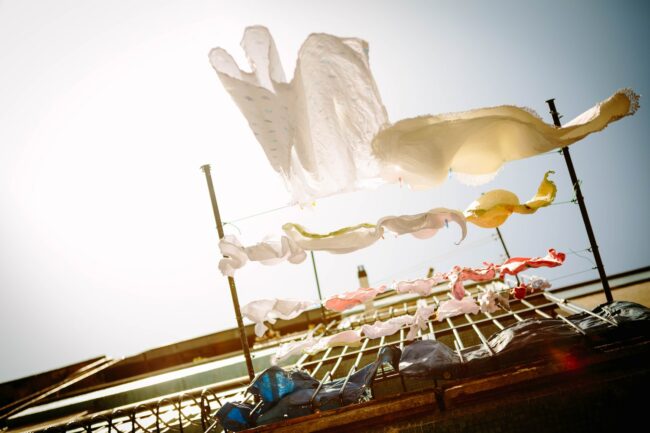Have you ever been caught in a rainstorm and wondered how long it would take for your clothes to dry? Or perhaps you’re doing laundry and in a time crunch, wishing your clothes would dry faster. Either way, you’ve come to the right place. We offer a comprehensive guide on how long it takes for water to dry on clothes and how to speed up the process, ensuring you never have to deal with damp clothes for longer than you need to.
Table Of Contents
−- Factors Influencing Clothes Drying Times: More Than Just Heat
- Speeding Up the Drying Process: Little Steps, Big Gains
- The Natural Method: Drying Clothes Outdoors
- Indoor Air-Drying: Achieving Efficiency Within Your Four Walls
- Electric Clothes Dryers: Weighing the Benefits and Drawbacks
- Tender Loving Care: Tips for Drying Delicate Fabrics
- Safe Air-Drying: How to Keep Your Clothes at Their Best
- Post-Drying Storage: Keeping Your Clothes Fresh and Ready
- Tackling Residual Moisture: The Final Step
Factors Influencing Clothes Drying Times: More Than Just Heat
When it comes to drying clothes, it’s not as simple as throwing them into the dryer or hanging them out on a line. Various factors come into play, each affecting the drying time in its own way:

- Fabric Type: Cottons and linens generally dry quicker than dense materials like wool and polyester. Different fabrics have different absorbency rates, affecting how quickly they dry.
- Humidity Levels: The higher the humidity, the longer it will take for your clothes to dry. The moisture in the air competes with the moisture in your clothes, effectively slowing down the evaporation process.
- Heat Settings: If you’re using a dryer, the heat setting you choose can drastically change the drying time. High heat may quicken the process but can also damage delicate fabrics.
By understanding these factors, you can make more informed decisions on how to dry your clothes most efficiently.
Speeding Up the Drying Process: Little Steps, Big Gains
If you’re tired of waiting for your clothes to dry, there are several effective strategies to expedite the process:
- Separate Laundry: Drying similar fabrics together and avoiding mixing heavy and lightweight items can make the drying process more efficient.
- Correct Cycle Settings: Always match the drying cycle to the type of fabric you’re drying. High heat for durable fabrics and low heat for delicate items.
- Absorbent Aids: Throwing a dry towel into the dryer with your wet clothes can significantly reduce drying time. The towel soaks up excess moisture, facilitating quicker drying.
- Clean Vents: Ensure your dryer’s vents are free from lint and other obstructions to maintain optimal airflow, which is crucial for efficient drying.
By following these tips, you can save both time and energy.
The Natural Method: Drying Clothes Outdoors
Hanging your clothes outside is not only eco-friendly but also leaves your clothes smelling fresh. However, there are some tips to keep in mind:
- Sunlight Exposure: Direct sunlight has natural antibacterial properties and accelerates drying. However, too much sun can fade the colors, so be vigilant.
- Weather Considerations: A clear, windy day is perfect for drying clothes outdoors. High humidity or rainy weather? Better to bring them inside.
By timing it right and considering the weather, you can master the art of outdoor drying without any fabric damage.
Indoor Air-Drying: Achieving Efficiency Within Your Four Walls
If you prefer to dry your clothes indoors, strategic placement is crucial. Areas with good airflow and lower humidity will be more effective for drying. Keep clothes near windows or fans and try to space them out to allow air to circulate around each piece.
Electric Clothes Dryers: Weighing the Benefits and Drawbacks
Electric dryers are a quick and convenient drying method. They are great for large loads and are generally more time-efficient than air drying. However, they do come with some downsides like high energy costs and the potential for fabric damage. You should carefully weigh these pros and cons when deciding whether an electric dryer is right for you.
Tender Loving Care: Tips for Drying Delicate Fabrics
Special fabrics like silk, lace, or wool need extra care. The key is to use a lower heat setting and avoid mixing them with heavier fabrics that may stretch or damage them. To air-dry delicate items, use padded hangers to maintain their shape.
Safe Air-Drying: How to Keep Your Clothes at Their Best
When air-drying clothes, location is key. Choose a well-ventilated area out of direct sunlight to prevent fading and deterioration. Remember to give each item enough space for air to circulate freely, reducing the chances of a musty odor developing.
Post-Drying Storage: Keeping Your Clothes Fresh and Ready
After ensuring your clothes are completely dry, fold them neatly and store them in a cool, dry place. For clothes that you don’t plan to wear for a while, consider using vacuum-sealed bags to protect them from dust and potential moisture.
Tackling Residual Moisture: The Final Step
Even after your clothes appear dry, they may still retain some moisture. This can be resolved by air-drying them for a few additional hours in a well-ventilated area. Alternatively, you can use a dehumidifier to remove any lingering dampness, ensuring that your clothes are completely dry and ready for storage.
So there you have it—an exhaustive guide to getting your clothes dry as efficiently as possible. Now, you don’t have to wonder or wait impatiently; you have the knowledge to make the drying process work for you.

Editorial Staff
Our writers, editors, content managers, and SEO specialist. We all take part in crafting amazing articles. We spend hours ensuring that each article is based on facts, researched, and thorough. You'll never want to click the back button to look for more answers other than here!
